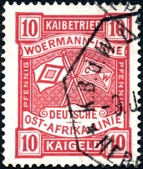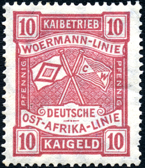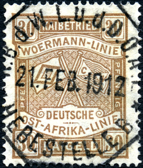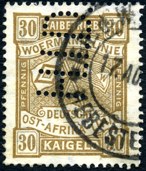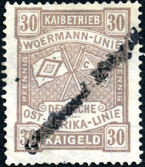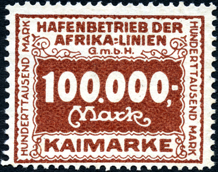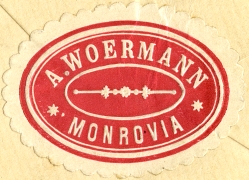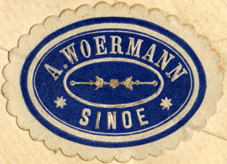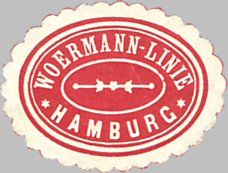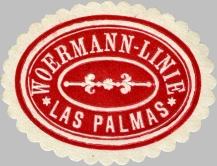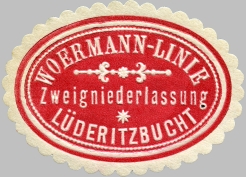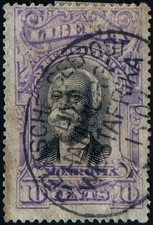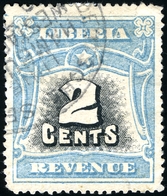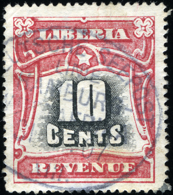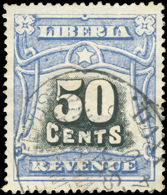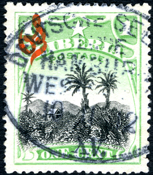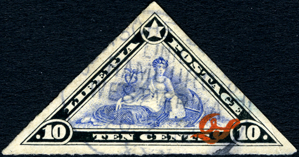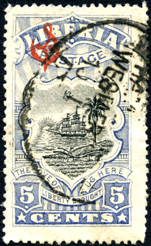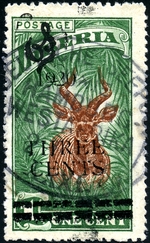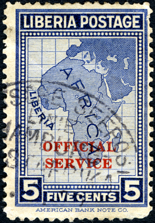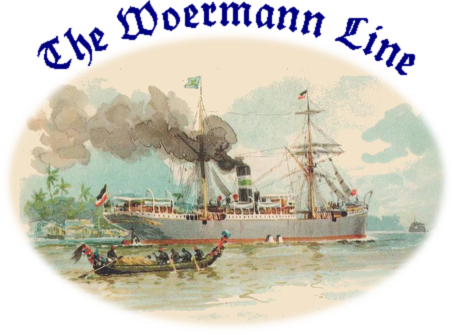
The Woermann Steamship Line of Hamburg
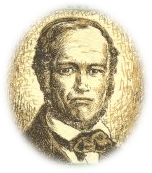 The history of the Woermann shipping line begins
with the founding of the trading company “C. Woermann”, Hamburg, Germany, by
Carl Woermann on October 1, 1837.
Woermann, born in Bielefeld on March 11, 1813, as the son of an owner of a linen company, had already
gained a wide knowledge of trading business in his father’s firm when he decided to launch his
own company for the import of overseas products.
After a few years of trade with South America – where his family had traditionally sold linen
since two and a half centuries – but also the West Indies and Australia, Woermann turned to
Africa to explore the possibilities that were opening up in Liberia, where a new upper class of locals
had begun to establish.
In 1849, Woermann’s own brig “Therese Henriette” made her first journey to Liberia,
delivering European industrial goods in exchange for local products.
Since his first Africa adventure turned out to be successful, another ship, the new schooner
“Liberia” specifically designed for the Africa trade, was bought in 1852 and sent to
Liberia in 1854 to return loaded with ivory and palm oil.
Later in the same year the first branch office in Monrovia was opened.
By 1855 the trade with Germany had reached such a level that the Republic of Liberia signed her first
trade agreement with the Hanseatic cities of Hamburg, Bremen and Lübeck.
Woerman’s Africa trade had been developing well when his business was hit by the trade
recession of the year 1857 following the end of the Crimean War.
To bring his company back on course, Carl Woermann decided to more or less abandon his worldwide
activities in favour of the Africa trade.
Expanding along the West African coast, new branch offices were founded in Gabon (1862)
and in Cameroon (1868).
When Carl Woermann died on June 25, 1880, his company had become an epitome of Africa trade, with
a fleet of twelve sailing ships and the brand-new steamship “Aline Woermann”.
After Carl’s death he was succeeded by his second son Adolph, born on December 10, 1847
in Hamburg, and part owner of the company since 1874.
Not only did Adolph follow in his father’s footsteps; separating the shipping business from the
trading company he was also setting out to become head of the world’s largest privately owned
shipping line.
The history of the Woermann shipping line begins
with the founding of the trading company “C. Woermann”, Hamburg, Germany, by
Carl Woermann on October 1, 1837.
Woermann, born in Bielefeld on March 11, 1813, as the son of an owner of a linen company, had already
gained a wide knowledge of trading business in his father’s firm when he decided to launch his
own company for the import of overseas products.
After a few years of trade with South America – where his family had traditionally sold linen
since two and a half centuries – but also the West Indies and Australia, Woermann turned to
Africa to explore the possibilities that were opening up in Liberia, where a new upper class of locals
had begun to establish.
In 1849, Woermann’s own brig “Therese Henriette” made her first journey to Liberia,
delivering European industrial goods in exchange for local products.
Since his first Africa adventure turned out to be successful, another ship, the new schooner
“Liberia” specifically designed for the Africa trade, was bought in 1852 and sent to
Liberia in 1854 to return loaded with ivory and palm oil.
Later in the same year the first branch office in Monrovia was opened.
By 1855 the trade with Germany had reached such a level that the Republic of Liberia signed her first
trade agreement with the Hanseatic cities of Hamburg, Bremen and Lübeck.
Woerman’s Africa trade had been developing well when his business was hit by the trade
recession of the year 1857 following the end of the Crimean War.
To bring his company back on course, Carl Woermann decided to more or less abandon his worldwide
activities in favour of the Africa trade.
Expanding along the West African coast, new branch offices were founded in Gabon (1862)
and in Cameroon (1868).
When Carl Woermann died on June 25, 1880, his company had become an epitome of Africa trade, with
a fleet of twelve sailing ships and the brand-new steamship “Aline Woermann”.
After Carl’s death he was succeeded by his second son Adolph, born on December 10, 1847
in Hamburg, and part owner of the company since 1874.
Not only did Adolph follow in his father’s footsteps; separating the shipping business from the
trading company he was also setting out to become head of the world’s largest privately owned
shipping line.
 Flag of the Woermann Line until 1916, known to represent
“Cognac & Whiskey”.
Flag of the Woermann Line until 1916, known to represent
“Cognac & Whiskey”.
When Adolph Woermann took the lead, C. Woermann was still mainly a trading company.
Although they had entered the market as a shipping company as early as 1853 with the bark
“Carl”, shipping foreign freight only made up a small fraction of their business.
The advent of modern steamships with their much larger cargo space allowed them to intensify the
shipping activities.
Consequently, Woermann soon began selling their sailing ships to replace them with steamships.
Unlike sailing ships, steamships were also fairly independent of weather conditions, making the
length of the journeys much more predictable.
In 1882, C. Woermann was able to establish a scheduled service to Nigeria, and in 1884 to Cameroon.
One year later, Adolph Woermann finally decided that the shipping interests would be served best by
founding a dedicated shipping company: the African Steamship Inc., better known as Woermann
Line (“Afrikanische Dampfschiffs-Aktiengesellschaft, Woermann-Linie”).
Adolph Woermann also intensified a special kind of barter trade his father had begun: delivering brandy,
weapons and gunpowder to Africa in exchange for palmoil and caoutchouc.
The export of spirits and its implications were not without controversy.
When critized for it in the Reichstag in May 1889,
Woermann defended himself arguing that it had been exactly the brandy that had enabled Germany to get a
foothold in Africa and stay competitive.
In 1888, Adolph Woermann was approached by the government to develop plans for a shipping line for
East Africa, and in 1890 the Reichstag granted 900000 marks of subsidies per year for establishing an
East African shipping line for the next 10 years.
A consortium was formed by several German banks and traders, leading to the foundation of the German
East Africa Line (“Deutsche Ost-Afrika Linie, DOAL”) on April 19, 1890.
Although Woermann only had a 2.5 percent share in the seed money of six million marks, management was handed
over to the Woermann family due to their experience in Africa trade.
Eventually, with Adolph Woermann as chairman and his brother Eduard and brother-in-law J.F.E. Bohlen
forming the executive board the West and East African shipping lines were practically placed under the
same corporate lead.
One of the requirements for receiving the subsidies from the government was the establishment of a mail
service.
An official postal “clerk” was appointed for each ship and issued with an offical
postal cancelation for all mail posted on board, following U.P.U. regulations.
It is not exactly known when this mail service commenced operations, but the earliest recorded date
so far is 1894.
In 1895, the newly renamed “Woermann Linie GmbH” (Woemann Line Ltd.) formed the
“Société Maritime du Congo” in Antwerp for opening up services to the Congo.
After merging with the British operated “Compagnie Maritime Belge du Congo” into the now
completely Belgian owned “Compagnie Maritime Belge”, Antwerp became the main point of departure
and return in Europe of the Woermann Line.
Meanwhile, the expansion of regular services to the south had continued reaching German South-West Africa
(today Namibia) in 1891.
In 1898, the Woermann Line officially extended its schedule to Swakopmund, where a railroad from Windhoek
was nearing completion.
Being the only shipping line with a regular service to South-West Africa, the Woermann Line played a keyrole
in defeating the Herero uprising in 1904 - and in the campaign of destruction, that followed.
To deal with an ever increasing transport volume during the war, Woermann began
investing in new ships and in the development of on-site cargo facilities.
Within the next three years, the Woermann fleet doubled its capacity from 65000 gross tons to 130000 gross tons.
By the end of the war the Woermann Line would be almost solely responsible for the transport of 15000 troops and
11000 horses into the region.
Providing a constant supply for the men abroad and transporting that many horses with a loss rate far below
what was usual was a logistical masterpiece – and without a serious competitor, Woermann could dictate the price.
During a debate in the Reichstag in March 1906 the Woermann Line was accused of having overcharged its services
by six million Reichsmark.
Although Woermann’s position was supported by Albert Ballin, director of the HAPAG, who stated that the
high charges had been justified by extraordinary costs, the Woermann Line was regarded as war profiteer, and
Emperor Wilhelm II refused to have any further contact with Adolph Woermann.
After the war was over, the Woermann Line soon found itself struggling with an oversized fleet;
the situation got even worse when Menzell & Co., a company mainly serving the Chinese coast in the past, decided to refocus its activities towards West Africa.
Although the newly founded Hamburg-Bremer Africa Line (HBAL) was quickly defeated, the threat
became real when the HBAL was taken over by one of the most influential German shipping lines, the North German Lloyd of Bremen
(“Norddeutscher Lloyd, NDL”).
To keep the NDL at arm’s length, Woermann accepted an offer from Albert Ballin: in exchange
for taking over eight steam ships from Woermann, the HAPAG would receive 25% of the German liner services to West Africa, to be managed by the Woermann Line.
The agreement between the HAPAG, Woermann and the DOAL was signed in 1907.
Only one year later the HBAL also entered the joint venture, eliminating any competition between Woermann and the NDL.
Once again the German West Africa trade was entirely in the hands of the Woermann Line.
In 1911, Adolph Woermann died at the age of 64.
The Woermann Line as well as the trading company kept expanding until 1914.
With the outbreak of the First World War all sea routes to West Africa were blocked off.
Trading posts and other assets in Cameroon, Liberia and Gaboon were lost and had to be written off.
Ships were either stuck in neutral ports, confiscated or even sunk at sea by the allies.
In 1916, Adolph Woermann’s successor Eduard Woermann decided that it was unlikely the shipping
line would ever be built up again.
Concentrating on the trading company, he sold all shares in the Woermann Line and the DOAL to a syndicate company of HAPAG, NDL, Hugo Stinnes and others (HAPAG and NDL became majority
shareholders with 37.5% each when they bought Stinnes’ shares in 1921).
Although the shipping line had lost any connection with the Woermann family, the new
owners decided to keep the name due to its popularity along the African coast, only replacing
the initials of the founder on the shipping flag with those of the shipping line,
i.e. “W L”.
Two years after the end of the hostilities, the steamer “Pallas” was sent out
to reestablish the old links the Germans had in West Africa before the war.
The mission was a success, allowing the German shipping lines of HAPAG and NDL, now operating
under the name “Deutscher Afrika-Dienst” (German Africa Service) to resume business by regularly calling at West African ports again.
In the same year, the trading company C. Woermann returned to Africa when Adolph
Woermann’s son Kurt was able to reopen the trading station at Monrovia.
By 1923 the Woermann Line owned nine ships, including a new ship built the year before, the “Adolph Woermann (IV)”.
In addition to the branch office in Las Palmas – the only one that had survived the war
– new offices were opened in Lagos (Nigeria, 1922), Beira (Mozambique, 1922) and Accra (Ghana, 1923).
In 1924 the German Africa Service was strong enough to convince
British shipping lines into reviving old agreements that had regulated the Africa service until
1914.
Like before, this allowed the shipping lines of both countries to thrive without having to
compete with each other.
By the time the worldwide economy was hit during the “Great Depression” of the 1930s,
the German Africa fleet had grown to a total of eleven passenger steamers and thirteen
freighters (Woermann Line, DOAL and HBAL), with fourteen branch offices around the African
continent.
After Adolf Hitler seized power in Germany, he decreed a complete reorganization of the
German navigation, breaking up the agreements and joint ventures that had been formed during the
past decades, and forcing HAPAG and NDL to sell their shares in the German Africa Service to the
German Reich.
Although the three shipping lines serving Africa would act together as “Deutsche Afrika-Linien”,
Woermann Line, DOAL and HBAL basically became independent again, which almost restored the situation from before 1907.
The Woermann Line had just been back on track for a few years, when the outbreak
of the Second World War put an end to its success story – again – and this time it would be final.
In 1941, the Reich sold its shares in the Woermann Line and DOAL to cigarette producer Philipp F. Reemtsma.
Only one year later Reemtsma passed them on to shipping company owner John T. Essberger.
After the war Essberger decided to give up the Woermann Line in favor of continuing the DOAL alone
under the name Deutsche Afrika-Linien (DAL).
Today, the Woermann Line is history, but the trading company C. Woermann still exists with branch offices in Angola, Ghana and Nigeria, looking back at more than one and a half century of trade in Africa.
- Literature:
-
- : The Woermann Steamship Line of Hamburg. Series Booklet No. 11. Published by House of Antiquity.
- : Geschichte der Woermann- und Deutschostafrika-Linie. Hamburg, 1935.
- : Wagnis Westafrika. Verlag Hanseatischer Merkur, 1987.
Harbor Fee Stamps of the German Steamship Lines Serving West Africa
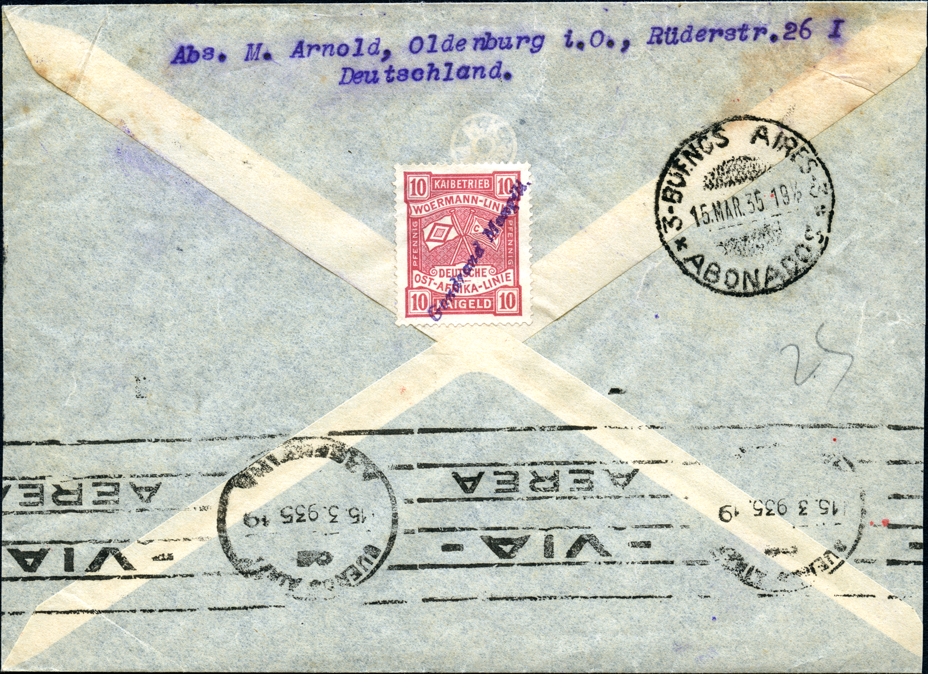
- Literature:
-
- : Catalogue of the Adhesive Revenues of Germany. Published by ORA–Verlag, Icking, Germany.
- German Colonies and Overseas Steamship Lines. 37pp.
- : Catalogue of the Adhesive Revenues of Germany. Published by ORA–Verlag, Icking, Germany.
Woermann Linie - DOAL
Kaigeld=wharfage, Theilschein=charter-party
Kaigeld Woermann-Linie AG 1903
-
5 Pf.
blue1903BCB1 -
10 Pf.
carmine rose1903BCB2 -
30 Pf.
light brown1903BCB3 -
50 Pf.
dark gray1903BCB4 -
1 M
light green1903BCB5 -
 1903BCB6
1903BCB6
-
Kaibetrieb Woermann-Linie 1903
-
1 M
violet1903BCB7 -
30 Pf.
blue1903BCB8
-
Kaigeld Woermann-Linie 1908
Kaibetrieb Woermann-Linie 1908
-
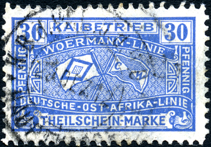 1908BCB16
1908BCB16 -
60 Pf.
dark blue1908BCB17 -
1 M
green1908BCB18
-
Kaigeld Woermann-Linie 1920
-
5 M on 10 Pf.
rose1920BCB19
-
Afrika Linien GmbH
wharfage stamps of the operating consortium comprising the Woermann Line, DOAL, HAPAG and the Hamburg–Bremen Africa Line.
Kaimarken 1910/1921
-
 1910/1921BCA1
1910/1921BCA1 -
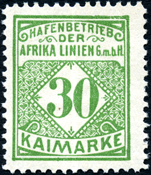 1910/1921BCA2
1910/1921BCA2 -
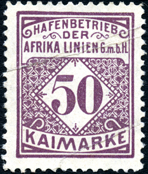 1910/1921BCA3
1910/1921BCA3 -
60 Pf.
blue1910/1921BCA4 -
1 M
green olive1910/1921BCA5 -
3 M
orange1910/1921BCA6 -
 1910/1921BCA7
1910/1921BCA7
-
Kaimarken 1919/1922
-
10 M
dark blue1919/1922BCA8 -
20 M
dark bluish green1919/1922BCA9 -
 1919/1922BCA10
1919/1922BCA10 -
100 M
orange1919/1922BCA11 -
 1919/1922BCA12
1919/1922BCA12 -
 1919/1922BCA13
1919/1922BCA13
-
Kaimarken 1919/1922 surcharged
-
2 M on 60 Pf.
blue1919BCA14 -
 1919/1922BCA15
1919/1922BCA15 -
 1919/1922BCA16
1919/1922BCA16 -
 1919/1922BCA17
1919/1922BCA17 -
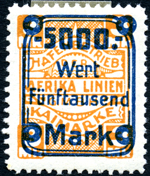 1919/1922BCA18
1919/1922BCA18
-
additional values 1923
Woermann Line and Trading Company Seals
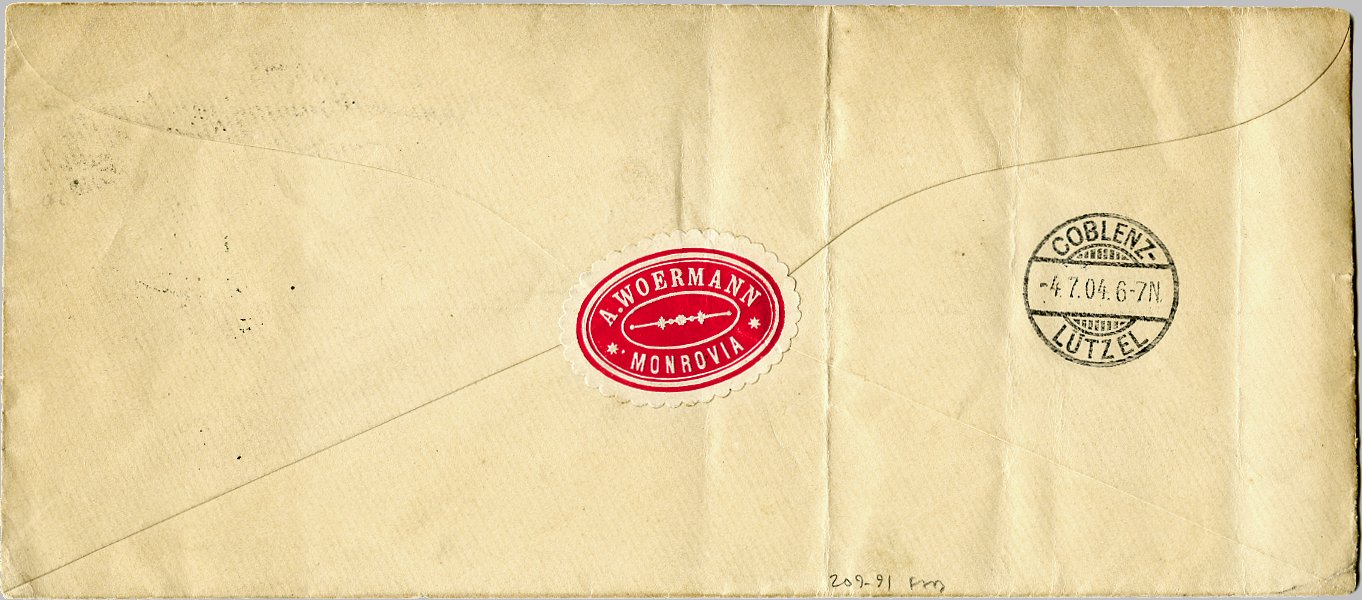
Paper Seals
envelope seals made from paper came into use around 1850; replacing the usual wax seals at public authorities, they reached the height of their popularity in the first two decades of the 20th century, when it became customary for private businesses as well to have their own seals printed for representative purposes; the typical paper seal was round with a diameter less than two inches, pre-gummed like a stamp and had an embossed imprint showing a crest and the sender’s identification; after 1920, they became less and less common until there were only a few offices left using them in the 1930s.
German Seepost Cancelations on Liberian Stamps
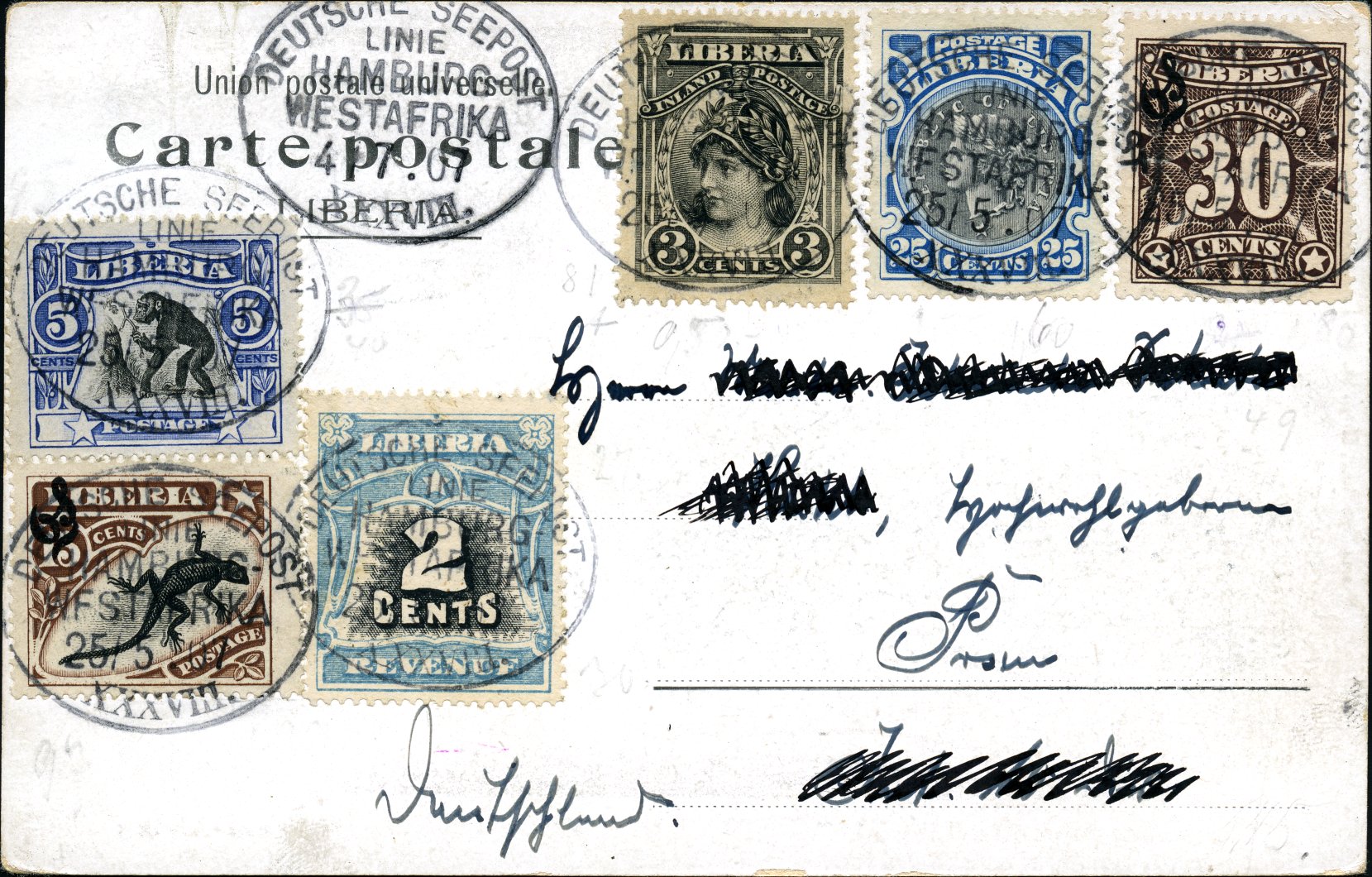
Besides stamps being canceled with any of the internal postmarks collectors of
Liberian stamps often come across specimens with cancels reading DEUTSCHE SEEPOST or, much less frequently,
DEUTSCHE SCHIFFSPOST.
Most of these stamps come from mailings sent through the “ship mail services” provided by the
Woermann Steamship Line from 1894 to 1939. Instead of relying on the local postal service the sender would hand
over his letter or postcard to a ship’s personnel just before the vessel left port.
On the West African route, lacking an onboard post office led by government postal personnel, this kind of mail
was handled and canceled by the ship’s purser.
By far the most frequent SEEPOST cancels encountered are oval postmarks with LINIE HAMBURG-WESTAFRIKA in
the center and Roman numerals at the bottom indicating the ship and ranging from I to LXIII (Cockrill types WA.1
and WA.2).
Whether all 63 actually exist on Liberian stamps, is not known.
- Literature:
: Handbook series. Published by House of Antiquity.- German Maritime Cancellations on Liberian Stamps. 32pp.
- The Woermann Steamship Line of Hamburg. 34pp.
- German “Seepost” Cancellations 1886-1939 Part I: The European, North & South Atlantic Routes. 116pp.
- German “Seepost” Cancellations 1886-1939 Part II: The African, Asian & Australasian Routes. 116pp.
Early Boxed Types


type 1
1885–1905type 2
1886–1898Type WA.1 and WA.2


WA.1
(without stop)WA.2
(with stop)1894–1936 1880 Allegory of Liberty
1881 - 1903 Inland Postage
1892 - 1905 Pictorials
-
 34 - XII. - (4/7.01)
34 - XII. - (4/7.01)
-
 38 - XIX - (11.3.99)
38 - XIX - (11.3.99)
-
 40
40
-
 42
42
-
 44
44
-
 45 - XIX - (21.3.02)
45 - XIX - (21.3.02)
-
 50 - XIX - (10.12.06)
50 - XIX - (10.12.06)
-
 54
54
-
 54a
54a
-
 55
55
-
 56 - XXVIII - (9.6.07)
56 - XXVIII - (9.6.07)
-
 57
57
-
 58 - (20.6.04)
58 - (20.6.04)
-
 59 - XXIII.
59 - XXIII.
-
 60
60
-
 61 - XXIV.
61 - XXIV.
-
 62 - XVII. - (11.9.11)
62 - XVII. - (11.9.11)
-
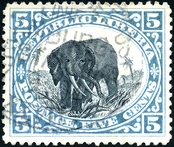 62_light_blue - XXVII.
62_light_blue - XXVII.
-
 91
91
-
 95
95
-
 97 - (x/5.12)
97 - (x/5.12)
-
 98
98
-
 99 - XX
99 - XX
-
 O1
O1
-
 O2 - XLII.
O2 - XLII.
-
 O15 - XXXII.
O15 - XXXII.
-
 O22
O22
-
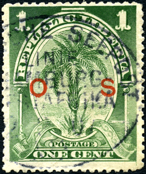 O29
O29
-
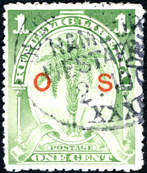 O30
O30
-
 O32
O32
-
 O35 - (15.5.03)
O35 - (15.5.03)
-
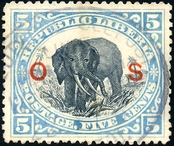 O36_light_blue
O36_light_blue
-
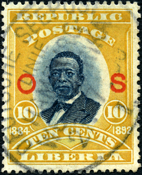 O37 - I.
O37 - I.
-
 O38
O38
-
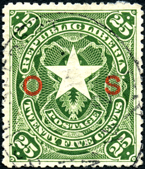 O40
O40
-
 O42
O42
-
 O45
O45
-
1903 Gibson Registered
1906 Pictorials
1906 Revenues
1909 - 1912 Pictorials
1918 Pictorials
1921 Pictorials
1923 Landing of First Settlers at Cape Mesurado
1923 Pictorials
1928 Pictorials
Type WA.3

1924–1939 Type WA.4

1931–1939 Type WA.5

1936–1939
